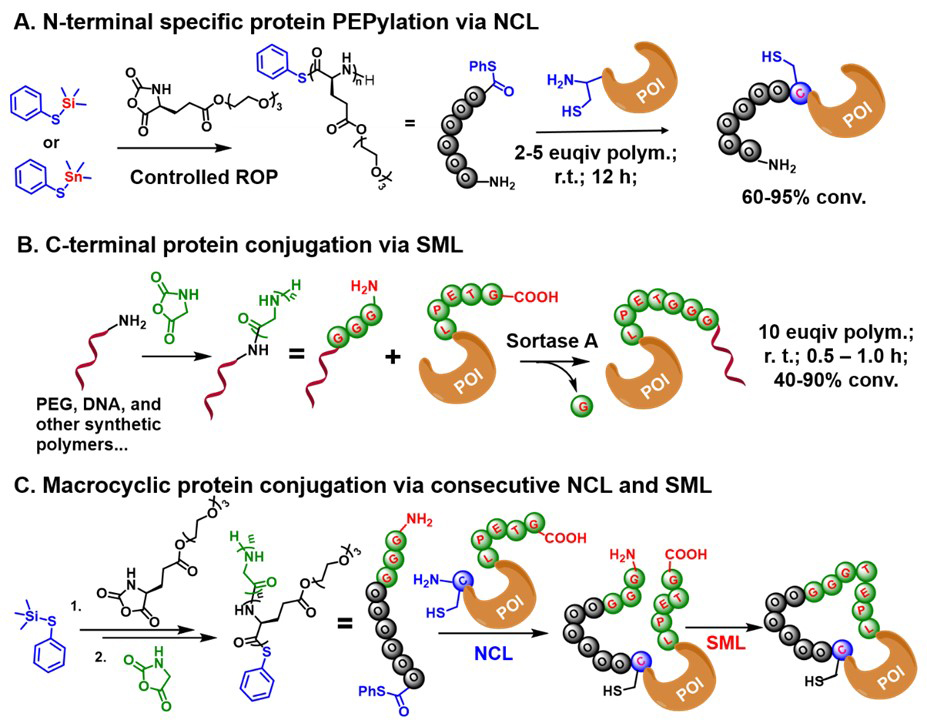Overview
Proteins are biological macromolecules with precise structure, hierarchical folding, and versatile functions. However molecules with such delicate structures are intrinsically vulnerable to environmental stresses including heat, pH, and organic solvents, making their broad applications inconvenient and costly. Particularly, the pharmacological performance of protein drugs often suffer from rapid proteolytic degradation, renal filtration, and strong immunogenicity. To this end, the overarching goal of the Lu lab at Peking University is to develop tools for the controlled synthesis of novel biomimetic polymers and protein conjugates to address unmet biomedical needs. To do this, we integrate and harness the power of organic/polymeric synthesis, molecular design, protein engineering, nanotechnology, and advanced biotechnologies. On this theme, we have been rigorously pursuing three focused directions outlined below:

Direction 1: In-situ functionalization of synthetic polypeptides for facile protein-polypeptide conjugation (PEPylation).
Due to the multi-functionality nature of both protein and polymer, traditional ways coupling this two types of macromolecules are tedious, low efficient, and lack of control on site-specificity. We tackled the problem by developing several methods that can in situ functionalize synthetic polypeptides with desired biorthogonal reactivity for rapid and site-specific bioconjugation (Biomacromolecules, 2016; ACS Macro Lett. 2018; J. Am. Chem. Soc. 2016). The new methods significantly facilitated the protein PEPylation by eliminating efforts for protection, deprotection, and/or pre-/post- modifications. Site-specific conjugates with well-defined topology (e.g. macrocyclic conjugates for the first time) can be readily accessible within 2-3 steps in modest-to-high yield.

Direction 2: Design and synthesis of degradable and/or recyclable functional polymers based on amino acids.
To expand the library of polymers for protein conjugation, we have developed many functional polymers based on amino acids. For example: phosphatase-cleavable poly(phosphotyroine) mimicking an important protein post-translational modification (ACS Macro Lett. 2015; Biomater. Sci. 2017; ACS App. Mater. Interfaces 2017), photo/thermal- and salt/pH- dual responsive polypeptides (Polym. Chem. 2016; Biomacromolecules, 2018), neutral and zwitterionic polypeptides showing helix-dependent nonfouling, adhesion, and cellular internalization behaviors (Biomaterials, 2018; ACS App. Mater. Interfaces 2018; Nano Res. 2019). More recently, we developed hydroxyproline-derived sustainable polythioesters with complete recyclability for the first time (J. Am. Chem. Soc. 2019). Ligations of those functional polymers to proteins are expected to pronouncedly enrich the scope of protein-polymer hybrids and stimulate a broad range of new applications.

Direction 3: In vivo structure-activity relationship (SAR) analysis and therapeutic applications of PEPylated proteins.
Structurally ill-defined and poorly-characterized protein-polymer conjugates are difficult to optimize their efficacy. We have successfully applied our well-defined protein conjugates for careful in vivo SAR studies. We discovered that macrocyclic interferon PEPylation can impart unusual deep tumor penetration and enhanced antitumor efficacy (J. Am. Chem. Soc. 2018). Moreover, our investigation on the polymer conformation effect unexpectedly revealed that the helix of nonfouling polypeptides can minimize antidrug antibody and antipolymer antibody generation (ACS Cent. Sci. 2019). These works highlight the remarkable benefits of structural precision and may inspire new design principles of PPCs. We also developed a simple and universal formulation generating high-loading protein-polymer nanoconjugates for systemic delivery and traceless release of proteins to the cytosol of tumor cells, which may potentiate versatile proteins therapeutics that act on intracellular targets (Adv. Funct. Mater. 2018).

 Lu Research Group
Lu Research Group
